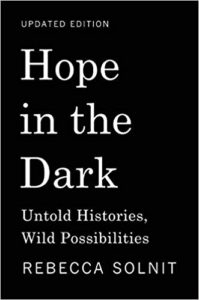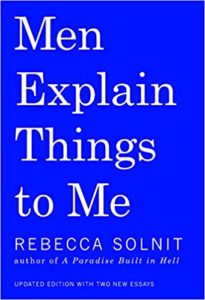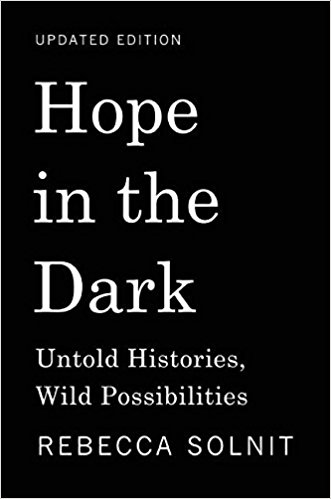Rebecca Solnit: Two Books for Activists
Coming out of Women’s History Month, I wanted to share with you a women historian, writer and activist I recently discovered. Rebecca Solnit has been active in social justice movements and writing for nearly forty years. How is it that I just found out about her? She’s the author of twenty or so books on feminism, western and indigenous history, popular power, social change and insurrection, wandering and walking, hope and disaster, including the books Hope in the Dark and Men Explain Things to Me. She’s written a trilogy of atlases of American cities; A Paradise Built in Hell: The Extraordinary Communities that Arise in Disaster; A Field Guide to Getting Lost; and River of Shadows, Eadweard Muybridge and the Technological Wild West (for which she received a Guggenheim, the National Book Critics Circle Award in criticism, and the Lannan Literary Award). A product of the California public education system from kindergarten to graduate school, she is a columnist at Harper’s and a regular contributor to the Guardian.
That’s her CV. This is how I finally learned about her. Last winter, Bob Garfield, one of the hosts of the NPR radio show “On the Media” was in such despair after the election that he said during a staff phone call that he had trouble getting out of bed in the morning. One of the other people on the call asked, “Have you heard of Hope in the Dark by Rebecca Solnit?” He hadn’t, but contacted Solnit and had her on his show to talk him down. (You can listen to the segment here.)
This was my first introduction to Solnit and I loved what I heard. I immediately bought her books, which did uplift me, and now I want to share.
Hope in the Dark: Untold Histories, Wild Possibilities
From the back:
“A book as powerful and influential as Rebecca Solnit’s Men Explain Things to Me, her Hope in the Dark was written to counter the despair of radicals at a moment when they were focused on their losses and had turned their back to the victories behind them—and the unimaginable changes soon to come. In it, she makes a radical case for hope as a commitment to act in a world whose future remains uncertain and unknowable. Drawing on her decades of activism and a wide reading of environmental, cultural, and political history, Solnit argued that radicals have a long, neglected history of transformative victories, that the positive consequences of our acts are not always immediately seen, directly knowable, or even measurable, and that pessimism and despair rest on an unwarranted confidence about what is going to happen next. Now, with a moving new introduction explaining how the book came about and a new afterword that helps teach us how to hope and act in our unnerving world, she brings a new illumination to the darkness in an unforgettable new edition of this classic book.”
 I am a naturally optimistic person, but even I had been beaten down by the seemingly total rout of all my progressive ideals in the 2016 election. The elevation of hate, misogyny and racism as an antidote to “political correctness;” the false blame of “others” (read “immigrants”) for the economic woes caused by the greedy unregulated financial industry; the constant attacks on women’s health and reproduction; the common acceptance of sexual assault as okay in a presidential candidate; and the blatant attempt to scapegoat and whip up domestic fear of an entire religion appalled me.
I am a naturally optimistic person, but even I had been beaten down by the seemingly total rout of all my progressive ideals in the 2016 election. The elevation of hate, misogyny and racism as an antidote to “political correctness;” the false blame of “others” (read “immigrants”) for the economic woes caused by the greedy unregulated financial industry; the constant attacks on women’s health and reproduction; the common acceptance of sexual assault as okay in a presidential candidate; and the blatant attempt to scapegoat and whip up domestic fear of an entire religion appalled me.
I’ve been an activist for women’s rights and environmental justice for over 40 years and I couldn’t see a way forward. Reading this book gave me back my optimism. Rebecca Solnit is on a crusade to help activists turn back to hope as an antidote to despair and burn out. She points out that people have made great changes in the world and can continue to do that in the future. Every defeat is temporary. There is no end point or utopia; it’s the journey that counts. Every page contained something profound. I started highlighting but gave up because most of the book would be covered in day-glo colors. If you need a pick-me-up, I highly recommend this book.
Since reading this book in the winter of 2017, I’ve been even more buoyed by the active resistance to hate and ignorance that has broken out. I marched in the Women’s March the day after the presidential inauguration. My daughter jumped on a subway to protest at JFK airport when the Muslim ban was announced. My husband took time off work to canvass in the Virginia elections. The upcoming generation has proved its mettle with this past weekend’s March for Our Lives. People young and old, of all races and creeds are working for peace and justice across this country. Rebecca Solnit was right: every defeat is temporary. Keeping this in mind keeps hope in the dark.
Men Explain Things to Me
From the back:
“In her comic, scathing essay “Men Explain Things to Me,” Rebecca Solnit took on what often goes wrong in conversations between men and women. She writes about men who wrongly assume they know things and wrongly assume women don’t, about why this arises, and how this aspect of the gender wars works, airing some of her own hilariously awful encounters. She ends on a serious note—because the ultimate problem is the silencing of women who have something to say, including those saying things like, “He’s trying to kill me!”
This book features that now-classic essay with eight perfect complements, including an examination of the writer Virginia Woolf ’s embrace of mystery, of not knowing, of doubt and ambiguity, a highly original inquiry into marriage equality, and a terrifying survey of the scope of contemporary violence against women.”
 Rebecca Solnit provides a funny but sharp insight into the battle of the sexes in Men Explain Things To Me. The funny titular essay inspired the phrase “mansplaining” but she never uses the phrase. Solnit adds eight insightful essays covering most of the major issues raised by feminists. One that touched my heart as well as my head were “Worlds Collide in a Luxury Suite” dealing with rape and sexual harassment. Published in 2011 for TomDispatch it preceded the “Me too” movement by several years. It’s almost distressing how these issues persist even after years of work.
Rebecca Solnit provides a funny but sharp insight into the battle of the sexes in Men Explain Things To Me. The funny titular essay inspired the phrase “mansplaining” but she never uses the phrase. Solnit adds eight insightful essays covering most of the major issues raised by feminists. One that touched my heart as well as my head were “Worlds Collide in a Luxury Suite” dealing with rape and sexual harassment. Published in 2011 for TomDispatch it preceded the “Me too” movement by several years. It’s almost distressing how these issues persist even after years of work.
“In Praise of the Threat: What Marriage Equality Really Means” deals with the evolution of women as “equal” in marriage as an unintended consequence of gay marriage. I had never looked at that aspect of marriage equality before. In “Cassandra Among the Creeps” Rebecca Solnit deals with the issue of silencing women’s voices. I worked for several years in academia and with executives in Fortune 50 companies. This was one of my most challenging issues. (“And yet she persisted.”)
Each essay is illustrated with a haunting image by Ana Teresa Fernandez. It’s been decades since I’ve read any feminist philosophy. It was good to get back into the groove with this collection of thoughtful, sometimes funny, and always accessible essays. I hope more people learn about Rebecca Solnit and her writing. Highly recommended!
Here’s an extended interview with Solnit on being hopeful in the age of Trump:

